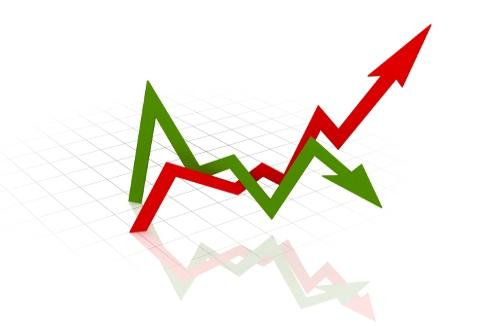On how to calculate the rate of growth and growth rate
Quite often for the analysis of any seriesdynamics use statistical indicators such as the growth rate in percent and the corresponding growth rate. At the same time, everything is usually clear with the first, but the second one often causes different questions concerning both the interpretation of the obtained value and the calculation formula itself. It's time to figure out how these values differ and how they should be properly determined.

Growth rate
This indicator is calculated in order toto find out how many percent is one value of the series from the other. In the role of the latter the most often used is the previous value or the basic one, that is, the one that is at the beginning of the series under investigation. If the result is more than 100%, this means that there is an increase in the studied indicator, and vice versa. Calculate the rate of growth is very simple: it is sufficient to find the ratio of the value for the reporting period to the value of the previous or basic time interval.

Unlike the previous one, this indicatorallows you to find out not how much, but how much the investigated value has changed. The positive value of the results of calculations means that the growth rate is observed, and the negative value is the rate of decline of the studied value in comparison with the previous or base period. How to calculate the growth rate? First, the ratio of the indicator to the baseline or the previous one is found, and then the unit is subtracted from the result, after which, as a rule, the total is multiplied by 100 to get it in percents. This method is used most often, but it happens that instead of the actual value of the analyzed indicator only the value of the absolute increment is known. How to calculate the growth rate in this case? Here you need to use an alternative formula. The second option is to find the percentage of absolute growth to the level, in comparison with which it was calculated.
Practice
Suppose we know that in 2010the joint-stock company "Bright Way" received a profit of 120,000 rubles, in 2011 - 110,400 rubles. And in 2012 the amount of income increased compared to 2011 by 25,000 rubles. Let's see how to calculate the rate of growth and growth rate based on available data, and which of this can be inferred.
1. Calculation of indicators for 2011.
The growth rate is 110,400 / 120,000 = 0.92 or 92%.
Conclusion: In 2011, the company's profit compared to the previous year was 92%.
The growth rate is 110,400 / 120,000 - 1 = -0.08, or -8%.
This means that in 2011 the income of JSC "Svetly Put" compared to 2010 decreased by 8%.
2. Calculation of indicators for 2012.
Growth rate = (120 000 + 25 000) / 120 000 ≈ 1.2083 or 120.83%.
This means that the profit of our company in 2012 compared to the previous year, 2011, amounted to 120.83%.
The rate of growth = 25 000/120 000 - 1 ≈ 0.2083 or 20.83%.
Conclusion: the financial results of the analyzed enterprise in 2012 were higher than the corresponding indicator of 2011 by 20.83%.

Conclusion
After we figured out how to calculaterate of growth and growth rate, we note that on the basis of only one indicator it is impossible to give an unambiguously correct estimate of the phenomenon under study. For example, it may well turn out that the magnitude of the absolute increase in profit increases, and the development of the enterprise slows down. Therefore, any signs of dynamics should be analyzed together, that is, in a complex manner.
</ p>
